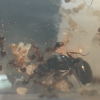Edited by Amazant, August 27 2019 - 2:01 PM.
- Formiculture.com
- Forums
- Gallery
- Members
- Member Map
- Chat

Edited by Amazant, August 27 2019 - 2:01 PM.
Edited by Amazant, August 16 2019 - 8:15 PM.
Get a pic. Also, hard to take care of? You can dump several hundred queens and a few thousand workers together, only feed them honey and they occasional protein, and they will thrive. Personal opinion, but they are the most boring ant species. They do nothing that interesting and just run around. Large colonies are fun to observe, like maybe doromyrmex level, but it takes a lot of fused colonies to get that big quickly. They will also reproduce within the nest, so a lot of new queens. Sorry if I sound negative, but I find small, monotypic, generalists kinda disappointing to keep. Good for beginners, though, and they farm aphids.
Argentine ants aren't found in Kansas. What you probably have is tapinoma sessile, the odorous house ant. They are pretty similar to Argentines although much smaller and release a disgusting stench when threatened.


Tapinoma sessile. Argentines have large social stomachs, but they have a longer thorax. Brachymyrmex tend to be a bit more compact.
Purdue wanted some specimens, you could send some to him.
Tapinoma are awesome they also reproduce in nest
Edited by Manitobant, August 18 2019 - 6:40 PM.
Do you use fluon and did you fill the container with water and then put fluon around it or something? Thanks for all the advice, I’ll try my best to keep them but if I can would it be okay to give them back to the colony? I’ve introduced like 20 more ants to there colony and they are doing well and no escapees except for when I added some new ones and those got out.It is true that tapinoma are escape artists, but I've had great luck keeping my tapinoma melanocephalum (which are even better escape artists than sessile) contained in a tar heel ants mini hearth that is in turn contained in a small plastic container. I'm assuming that would also work with a test tube, just put the whole setup in the dark and they will be fine. I've only had 2 escapes since I got them, and that was only because I didn't secure the formicarium lid tight enough. They didn't breach the container any of these times though.
Edited by Amazant, August 19 2019 - 3:20 PM.
I havent tried fluon and I don't use water, just a setup Inside a container.Do you use fluon and did you fill the container with water and then put fluon around it or something? Thanks for all the advice, I’ll try my best to keep them but if I can would it be okay to give them back to the colony? I’ve introduced like 20 more ants to there colony and they are doing well and no escapees except for when I added some new ones and those got out.It is true that tapinoma are escape artists, but I've had great luck keeping my tapinoma melanocephalum (which are even better escape artists than sessile) contained in a tar heel ants mini hearth that is in turn contained in a small plastic container. I'm assuming that would also work with a test tube, just put the whole setup in the dark and they will be fine. I've only had 2 escapes since I got them, and that was only because I didn't secure the formicarium lid tight enough. They didn't breach the container any of these times though.
Also do you need a picture of the setup?
Also ANTDrew why don’t you recommend keeping them just because they easily escape?
What do you use as a barrier then?I havent tried fluon and I don't use water, just a setup Inside a container.Do you use fluon and did you fill the container with water and then put fluon around it or something? Thanks for all the advice, I’ll try my best to keep them but if I can would it be okay to give them back to the colony? I’ve introduced like 20 more ants to there colony and they are doing well and no escapees except for when I added some new ones and those got out.It is true that tapinoma are escape artists, but I've had great luck keeping my tapinoma melanocephalum (which are even better escape artists than sessile) contained in a tar heel ants mini hearth that is in turn contained in a small plastic container. I'm assuming that would also work with a test tube, just put the whole setup in the dark and they will be fine. I've only had 2 escapes since I got them, and that was only because I didn't secure the formicarium lid tight enough. They didn't breach the container any of these times though.
Also do you need a picture of the setup?
Also ANTDrew why don’t you recommend keeping them just because they easily escape?
Edited by Amazant, August 21 2019 - 6:31 PM.
Click "Edit" on the first post, the "Use Full Editor." You will then be able to edit the title.
Hi there! I went on a 6 month or so hiatus, in part due, and in part cause of the death of my colonies.
However, I went back to the Sierras, and restarted my collection, which is now as follows:
Aphaenogaster uinta, Camponotus vicinus, Camponotus modoc, Formica cf. aserva, Formica cf. micropthalma, Formica cf. manni, Formica subpolita, Formica cf. subaenescens, Lasius americanus, Manica invidia, Pogonomyrmex salinus, Pogonomyrmex sp. 1, Solenopsis validiuscula, & Solenopsis sp. 3 (new Sierra variant).
0 members, 0 guests, 0 anonymous users